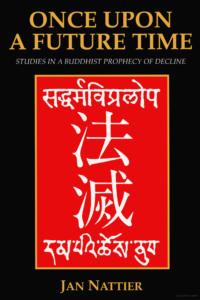Day 28 covers all of Chapter 24, Wonderful-Voice Bodhisattva, and concludes the Seventh Volume of the Sutra of the Lotus Flower of the Wonderful Dharma.
Having
last month considered the reaction in the Sahā-World to Wonderful-Voice Bodhisattva’s samadhi, we consider the arrival of Wonderful-Voice Bodhisattva.
Thereupon Wonderful-Voice Bodhisattva, accompanied by eighty-four thousand Bodhisattvas, left his world [for the Sahā World]. As they passed through the [one hundred and eight billion nayuta] worlds, the ground of those worlds quaked in the six ways; lotus flowers of the seven treasures rained [on those worlds], and hundreds of thousands of heavenly drums sounded [over those worlds] although no one beat them. The eyes of [Wonderful-Voice] Bodhisattva were as large as the leaves of the blue lotus. His face was more handsome than the combination of thousands of millions of moons. His body was golden-colored, and adorned with many hundreds of thousands of mark of merits. His power and virtue were great. His light was brilliant. His body had all the characteristics of the muscular body of Narayana.
[Before he started,] he stepped on a platform of the seven treasures. The platform went up to the sky seven times as high as the tala[-tree, and moved through the sky, carrying him]. Together with the Bodhisattvas surrounding him respectfully, he came to Mt. Gṛdhrakūṭa of this Sahā-World, and descended from the platform of the seven treasures. He came to Śākyamuni Buddha, carrying with him a necklace worth hundreds of thousands. He worshipped the feet of the Buddha with his head, offered the necklace to the Buddha, and said to him:
“World-Honored One! I bring you a message from Pure-Flower-Star-King-Wisdom Buddha. [He wishes to say this.] Are you in good health? Are you happy and peaceful or not? Are the four elements of your body working in harmony or not? Are the worldly affairs bearable or not? Are the living beings easy to save or not? Do they not have much greed, anger, ignorance, jealousy, stinginess and arrogance, or do they? Are they not undutiful to their parents, or are they? Are they not di respectful to śramaṇas, or are they? Do they not have wrong views, or do they? Are they not evil, or are they? Do they not fail to control their five desires, or do they? World-Honored One! Did they defeat the Maras, who are their enemies, or not. Is Many-Treasures Tathāgata, who passed away a long time ago and has now come here riding in the stupa of the seven treasures, hearing the Dharma or not? [Pure-Flower-Star-King-Wisdom Buddha] also wishes to know whether Many-Treasures Tathāgata is peaceful and healthy, and able to stay long or not World-Honored One! Now I wish to see Many-Treasures Buddha World-Honored One! Show him to me!”
Thereupon Śākyamuni Buddha said to Many-Treasure Buddha, “This Wonderful-Voice Bodhisattva wishes to see you.”
Thereupon Many-Treasures Buddha said to Wonderful-Voice Bodhisattva:
Excellent, excellent! You have come here to make offerings to Śākyamuni Buddha, hear the Sūtra of the Lotus Flower of the Wonderful Dharma, and see Mañjuśrī and others.”
The Daily Dharma from April 1, 2023, offers this:
World-Honored One! I bring you a message from Pure-Flower-Star-King-Wisdom Buddha. [He wishes to say this.] Are you in good health? Are you happy and peaceful or not? Are the four elements of your body working in harmony or not? Are the worldly affairs bearable or not? Are the living beings easy to save or not? Do they not have much greed, anger, ignorance, jealousy, stinginess and arrogance, or do they? Are they not undutiful to their parents, or are they? Are they not disrespectful to śramaṇas, or are they? Do they not have wrong views, or do they? Are they not evil, or are they? Do they not fail to control their five desires, or do they?
The passage above is how Wonderful-Voice Bodhisattva greets Śākyamuni Buddha in Chapter Twenty-Four of the Lotus Sūtra. This Bodhisattva asks not only about the Buddha, but about those whom the Buddha benefits with his teaching. The Buddha answers that those he teaches have prepared through innumerable lives to receive his wisdom. The questions of Wonderful-Voice show how we obscure the teaching through our delusion and attachments.
The Daily Dharma is produced by the Lexington Nichiren Buddhist Community. To subscribe to the daily emails, visit zenzaizenzai.com

